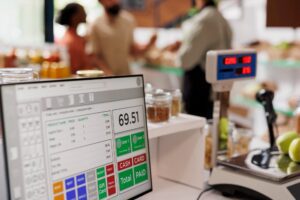One of the much-needed things in today’s fast-paced world of retail is a powerful supermarket POS system, and the level of help such would give in addressing everything from high transaction volumes to inventory management and customer service is unmatched. This supermarket POS system is critical for smooth operations, minimization of checkout times, and overall customer satisfaction.
This guide discusses the basic features of a supermarket POS system, sound security solutions, the contribution of onsite support, and the latest innovations in touch payment terminals.
Fundamental Features of Supermarket POS Systems

A good supermarket POS is designed to have all the features needed to meet the demands of high-volume retail environments. Here are some common features that differentiate a Supermarket POS System:
- Inventory Management: Supermarket POS systems keep track of stock in real-time. This makes it easier for managers to track what is available, set reorder alerts, and monitor product expiration dates. It helps avoid the shortage problem of out-of-stock situations due to the availability of the right products on shelves.
- System Integration: A good POS system integrates with other important retail tools, such as CRM systems and accounting software, to operate easily and with no problems. This integration enables supermarkets to have the same data on all the tools, thus aiding in the ease of making decisions and offering much more personalized service to customers.
- User-Friendly Interfaces: Grocery store workers work in fast-paced environments. A point-of-sale system that can use a simple, intuitive interface is imperative. When systems are user-friendly, training time for new employees is reduced, and it enables faster transaction processing so the checkout line moves along, and it improves the experience for the customer.
Ensuring Security with POS Systems

There is bound to be a huge number of transactions and sensitive information that supermarkets have to deal with. This is perhaps why POS security solutions are the first thing on the list in modern POS systems, ensuring customers’ data and secure transactions.
Key Security Features to Look For
- Data Encryption: It guards the customer against unauthorized access by covering sensitive information. In more advanced POS systems, data is automatically encrypted the instant any payment goes through.
- Tokenization: This feature replaces sensitive card information with unique tokens in case hackers manage to capture data in case of hacking.
- Fraud Detection: In some supermarkets, POSes have fraud detection algorithms that monitor real-time transactions by identifying suspicious activity and stopping fraudulent transactions.
- Compliance with Industry Standards: Look for POS systems that comply with Payment Card Industry Data Security Standards (PCI-DSS) to uphold full security and customer data protection. These standards are crucial for maintaining trust with customers and avoiding costly data breaches.
The Role of Onsite POS Support

For supermarkets, onsite POS support means you get things done in an instant; hence, it does not hurt operations. Unlike remote support, where connectivity or scheduling may hinder or delay the fix, onsite support means fast troubleshooting and repair, cutting downtime. This means less time spent waiting for technical help that supermarkets might have spent on serving customers.
Benefits of Onsite Support
- Quick Issue Resolution: Onsite support ensures fast troubleshooting and repair, cutting down on downtime. This means that for supermarkets, less time spent waiting for technical help would mean more time spent serving customers.
- Staff Training and Assistance: An onsite support team will train staff on the usage of the system, thereby making employees comfortable with the technology and maximizing its usage. On-site coaching eliminates errors and increases productivity.
- Preventive Maintenance: Onsite teams offer scheduled and regular checks to identify potential problems before the risk of an unplanned system outage increases.
Advancements in Touch Payment Terminals
Touch payment terminals are revolutionizing the checkout experience by providing speed and convenience for the customer to complete the transaction. In supermarkets, speed is essential, and touch payment terminals have some huge advantages.
How Touch Payment Terminals Make Customer’s Experience More Significant
- Faster Transactions: Through touch terminals, the checkout process is faster since there is a quick and efficient transaction. This minimizes waiting time and, thus, brings a better customer experience.
- Contactless Payment Options: Most touch payment machines have options for contactless payment platforms, which include mobile wallets like Apple Pay and Google Wallet. It is a more secure, flexible means of paying, particularly in fast-moving places such as supermarkets.
- Integration with Loyalty Programs: Some advanced touch payment machines are integrated with reward schemes that enable customers to accrue points or enjoy their discounts directly. Integration with a reward scheme improves the customer experience and makes them come back again and again.
Case Studies: Success Stories of Supermarket POS
Real-life examples prove the remarkable difference that supermarket POS systems can create. Some cases through which high-tech advanced POS systems have assisted supermarkets are briefed in the following sections:
- Mid-Sized Grocery Chain: A regional grocery chain installed a new POS system that featured mobile touch payment terminals and enhanced inventory management. In response, checkouts witnessed a 15% reduction in time, while the customers became happier due to the reduced waiting time and faster transaction process.
- Local Supermarket with Onsite POS Support: A locally-owned supermarket decided to opt for onsite POS support and ensured there was no downtime for the provided service. It helped reduce its technical downtime to 30% and ensured it maintained steady operations during peak hours, thereby aiding in increasing sales volumes and making the customer experience smoother.
- Organic Food Market: Integrated digital loyalty features into their POS system so that customers can accumulate points at each point of purchase. This not only boosted customer engagement but also resulted in a 20% increase in returning shoppers over six months.
FAQs
What are some key features to look for in a supermarket POS system?
A Supermarket POS System should have inventory management, system integration with other tools, and a user-friendly interface to handle high-volume transactions smoothly.
How is onsite POS support different from remote support?
Onsite support provides immediate assistance, thus making it possible to resolve the problem quickly and train the hands-on staff. Remote support is sometimes limited by connectivity and availability.
What security measures should a POS system have?
Look for POS security solutions like data encryption, tokenization, fraud detection, and PCI-DSS compliance to ensure your customer’s data and the integrity of each transaction.
What will benefit the supermarket with touch payment terminals?
Touch payment terminals will bring faster, more contactless transactions. Also, loyalty-program integration will be possible through the speed and delight factors.
Conclusion
Investing in a high-end supermarket POS system may help to streamline operations, ensure security, and enhance customer experience. Advanced security solutions, onsite support, and touch payment terminals are all part of the package that puts supermarkets ahead in today’s fast-changing retail environment. Contact us immediately to create a business-unique POS for your supermarket that responds specifically to your needs.
